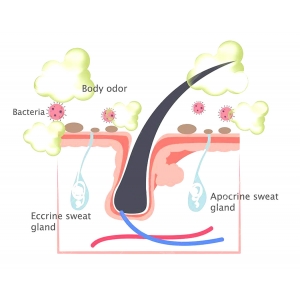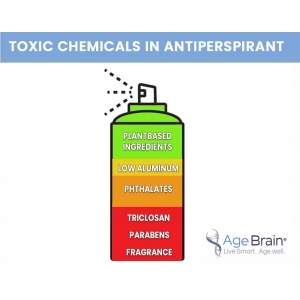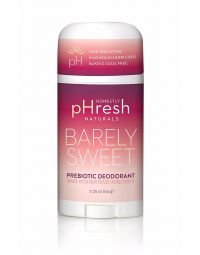The terms “deodorant” and “antiperspirant” are often used interchangeably, but the two are different things. Antiperspirants block sweat glands to reduce sweat production, while deodorants reduce body odor but do not affect sweating. The FDA classifies deodorants as cosmetic products while antiperspirants are over-the-counter drugs.

”Antiperspirant users who ceased using product initially had significantly lower abundances of bacterial colonies on culture plates than deodorant users who ceased using product” (NIH.gov)

What Causes Body Odor?
Body odor stems from sweat, or perspiration. However, the sweat itself is not what causes the smell. Rather, bacteria on your skin consume the acids and other molecules that are a part of sweat, and excrete odiferous gas afterward. This is the same reason why many people have bad smelling or tasting breath in the morning.1, 2
Sweating, or perspiring, is a natural process your body uses to regulate its temperature. When the environmental temperature is high or you have been exercising vigorously, your body temperature can begin rising. Some of your body heat is passed into sweat, which cools you off as it evaporates.1-4
Sweat is produced by sweat glands across the surface of your skin. You have two types of sweat glands: eccrine glands over most of your skin, and apocrine glands, associated with hair follicles. Apocrine glands are mostly located where there is a high concentration of hair, such as your armpits. The sweat from apocrine glands causes a particularly acrid smell when consumed by bacteria.1, 2, 4

How Deodorants Work
Deodorants do not reduce sweating, but control the odor that results. Some contain bactericidal agents that kill the bacteria responsible for making the smell. These are mild antimicrobial chemicals that are often used in cosmetics to prevent the growth of bacteria and fungi.5 Others use perfumes and fragrances to mask the odors produced by the bacteria.4
Because deodorants do not affect the structure or function of the body, and are not used to treat any medical conditions, they are classified by the FDA as cosmetics. They are regulated by the same safety rules and laws that apply to all cosmetic products.6 Some products commonly considered to be deodorants are actually antiperspirants, so check the ingredients list to see if a product contains any active ingredients with aluminum.
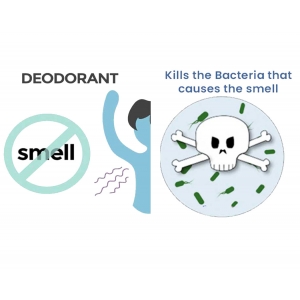

How Antiperspirants Work
Antiperspirants obstruct sweat glands to inhibit them from releasing sweat. The active ingredients in antiperspirants cause sweat to thicken and clump up. When your sweat glands are full and not expelling their fluid, they stop producing more. Eventually, after a few hours, these sweat plugs dissolve and your sweat glands return to normal function.3 Many antiperspirants also contain regular deodorant ingredients like antimicrobials and fragrances.
Because antiperspirants affect the function of part of the body, the FDA classifies them as over-the-counter drugs. This means that antiperspirant ingredients and products must meet specific safety and efficacy requirements.6
Our Recommendation: Try an MCT Oil with 100% C8 Caprylic Acid Triglycerides, which is the most effective in converting to ketones.
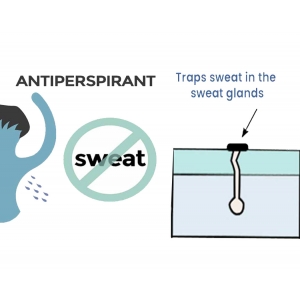

Antiperspirants Contain Aluminum, but at Safe Levels
The active ingredients in antiperspirants almost always contain aluminum. This metal can be toxic in very high levels, and concern was raised once about aluminum exposure from antiperspirant products. However, the amount of aluminum that you are exposed to from antiperspirants is low compared to that which you ingest from food and water.7 Recent research has found no link between antiperspirant use and risk for breast cancer or neurological disease.8
The one exception is for people with kidney disease. Your kidneys are responsible for clearing aluminum out of your bloodstream. If your kidney function is low, aluminum can build up in your body to toxic levels. Aluminum toxicity is frequently seen in patients undergoing kidney dialysis.7, 8 If you have any kind of kidney disease, check with your doctor before using an antiperspirant. Otherwise, look for deodorants which do not contain aluminum compounds.
[1] 2017. "Sweating and Body Odor."Mayo Clinic. Mayo Foundation for Medical Education and Research. https://www.mayoclinic.org/diseases-conditions/sweating-and-body-odor/symptoms-causes/syc-20353895.
[1] 2017. "Sweating and Body Odor."Mayo Clinic. Mayo Foundation for Medical Education and Research. https://www.mayoclinic.org/diseases-conditions/sweating-and-body-odor/symptoms-causes/syc-20353895.
[2] 2018. "Sweating and Body Odor."Cleveland Clinic. Cleveland Clinic. https://my.clevelandclinic.org/health/symptoms/17865-sweating-and-body-odor.
[3] IK Nyamekye. 2004. "Current therapeutic options for treating primary hyperhidrosis." Eur J Vasc Endovasc Surg. 27(6):571-6.
[4] A Natsch. 2015. "What Makes Us Smell: The Biochemistry of Body Odour and the Design of New Deodorant Ingredients." Chimia (Aarau). 69(7-8):414-20.
[5] JD Lee, JY Lee, SJ Kwack, CY Shin, HJ Jang, HY Kim, MK Kim, DW Seo, BM Lee, and KB Kim. 2019. "Risk Assessment of Triclosan, a Cosmetic Preservative." Toxicol Res. 35(2):137-154.
[6] 2018. "Cosmetics Safety Q&A: Personal Care Products."FDA. United States Food and Drug Administration. https://www.fda.gov/cosmetics/resources-consumers-cosmetics/cosmetics-safety-qa-personal-care-products.
[7] GL Klein. 2019. "Aluminum toxicity to bone: A multisystem effect?" Osteoporos Sarcopenia. 5(1):2-5. https://www.ncbi.nlm.nih.gov/pmc/articles/PMC6453153/
[8] K Klotz, W Weistenhofer, F Neff, A Hartwig, C van Thriel, and H Drexler. 2017. "The Health Effects of Aluminum Exposure." Dtsch Arztebl Int. 114(39):653-659.https://www.ncbi.nlm.nih.gov/pmc/articles/PMC5651828/

Search the blog
Article Categories
- All Articles (95)
- Rating Charts (1)
- Beauty & Skincare (17)
- FAQ (0)
- Hair Care (9)
- Health & Wellness (12)
- Anti-Aging (4)
- Kid's Health (0)
- Makeup (2)
- Men's Health (2)
- Oral Care (3)
- Sunscreen (7)
- Skin Tools & Treatments (10)
- Supplements (26)
- Videos (0)

